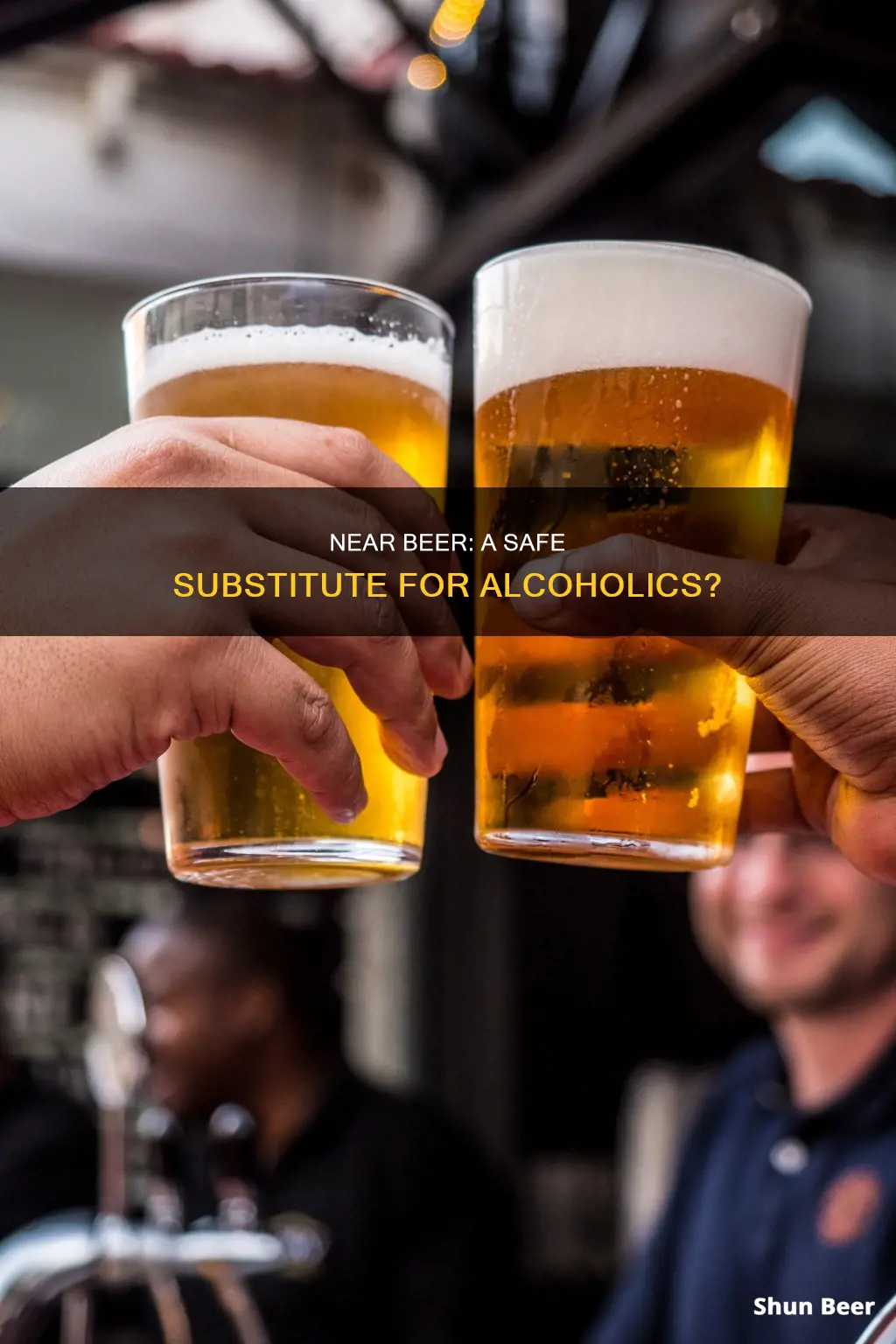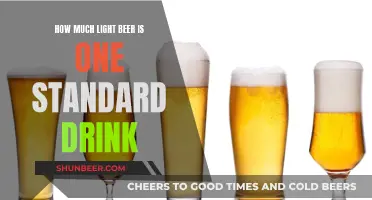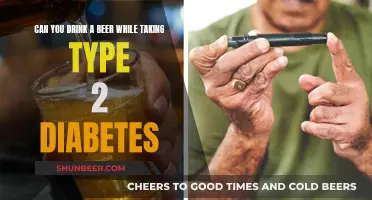
Alcoholics in recovery may be drawn to near beer or non-alcoholic beer to avoid feeling left out at social events where alcohol is being served. However, non-alcoholic beer can be dangerous for recovering alcoholics. While it's almost impossible for non-alcoholic beer to cause intoxication, it can be a powerful trigger, creating cravings that can lead to a relapse. Non-alcoholic beer still contains trace amounts of alcohol, typically around 0.5% ABV, compared to the average of 5% ABV for alcoholic beer. The look, smell, and taste of non-alcoholic beer are identical to regular beer, and this sensory experience can be a significant trigger for someone in early recovery. It can also trigger a condition called euphoric recall, where a recovering addict glamorizes their active addiction while ignoring the negative effects. For these reasons, recovering alcoholics should be cautious about consuming non-alcoholic beer and carefully consider their own triggers and risks before making a decision.
| Characteristics | Values |
|---|---|
| Alcohol content | Non-alcoholic beer usually contains around 0.5% ABV, but can contain up to 1% ABV. |
| Risk of relapse | The smell and taste of non-alcoholic beer can trigger cravings and a subsequent relapse. |
| Social benefits | Non-alcoholic beer can help people feel included at social events and reduce feelings of isolation. |
| Health risks | Consuming large amounts of non-alcoholic beer can cause hyponatremia, a condition where the body's sodium content drops to abnormally low levels. |
What You'll Learn

Non-alcoholic beer may contain alcohol
Non-alcoholic beer is often marketed as a safe alternative to alcoholic beer, and it can be a good option for people who are looking to cut down on their alcohol consumption. However, it's important to be aware that non-alcoholic beer may still contain small amounts of alcohol.
By law, non-alcoholic beers sold in the United States can contain up to 0.5% alcohol by volume (ABV). While this is a very small amount, it's important to note that some non-alcoholic beers may contain even higher levels of alcohol than this. Research has found that many non-alcoholic beers contain more alcohol than their labels indicate. For example, one study showed that 29% of no- or low-alcohol beers had higher alcohol levels than stated on their labels, with some containing up to 1.8% ABV.
The presence of alcohol in non-alcoholic beers poses a particular risk to certain groups of people. Firstly, pregnant women are advised to avoid non-alcoholic beers, as there is no known safe amount of alcohol consumption during pregnancy. Additionally, people with a history of alcohol abuse should be cautious about consuming non-alcoholic beers. The smell and taste of these drinks may act as triggers and lead to cravings and a potential relapse.
In summary, while non-alcoholic beer can be a good option for some people, it's important to be aware that it may still contain alcohol. For certain individuals, such as pregnant women and recovering alcoholics, the risks of consuming non-alcoholic beer may outweigh the benefits. It's crucial to read labels carefully, be aware of personal triggers, and make an informed decision about whether non-alcoholic beer is a suitable choice for you.
Breastfeeding and Beer: Is It Safe to Drink?
You may want to see also

It can trigger cravings and relapse
Non-alcoholic beer can trigger cravings and relapse in recovering alcoholics. The drink can be a powerful trigger, creating cravings that set up the circumstances for a relapse. The look, smell, and taste of non-alcoholic beer are identical to those of regular beer, and the sensory experiences associated with drinking beer can cause powerful cravings in recovering alcoholics.
The smell of beer alone may be enough to trigger a relapse in some individuals. A study by California scientists found that the smell of beer may be enough to trigger cravings and a subsequent relapse among certain people with alcohol use disorder. While this was an animal study, it suggests that the same effect may occur in humans.
Non-alcoholic beer can also trigger a condition known as euphoric recall, a form of selective memory in which a recovering addict glamorizes their active addiction while ignoring the negative effects it had on their life. In the face of extreme cravings, this problem intensifies.
Additionally, drinking non-alcoholic beer can serve as a behavioural crutch, allowing recovering alcoholics to continue participating in the rituals and behaviours associated with drinking. This can be dangerous, as it may lead to a false sense of security and a belief that one can control their drinking. It is important for recovering alcoholics to establish new hobbies, friendships, and behaviours that do not revolve around drinking.
The decision to drink non-alcoholic beer during recovery is a personal one, and there is no one-size-fits-all answer. However, it is crucial for individuals to be aware of their triggers and take steps to avoid high-risk situations. If non-alcoholic beer is a trigger for you, it is best to avoid it and stick to water or other non-alcoholic beverages.
Beer and Sawan: A Cultural Perspective
You may want to see also

It can be a psychological trigger
While non-alcoholic beer might not get you drunk, it can be a powerful psychological trigger for recovering alcoholics, creating cravings that set the stage for a relapse.
The look, smell, taste, and even the label and bottle of non-alcoholic beer are almost identical to those of regular beer. These sensory experiences associated with drinking beer can be a significant trigger for someone in early recovery. The same experiences, minus the intoxicating effect, can cause frustration and trigger a condition known as euphoric recall. Euphoric recall is a form of selective memory in which a recovering addict glamorizes their active addiction while ignoring all the negative effects it had on their life.
Research has also found that the smell of beer may be enough to trigger cravings and a subsequent relapse among certain people with alcohol use disorder. In a study, rats were trained to self-administer alcohol when they smelled a particular scent. Both alcohol and the anticipation of alcohol may raise levels of dopamine, a brain chemical that plays a role in feelings of elation and pleasure.
Additionally, drinking non-alcoholic beer can serve as a behavioural crutch. Recovering addicts must work every day to avoid a relapse, which means avoiding the people, places, and things associated with their drinking habit. Drinking non-alcoholic beer can be a slippery slope, creating urges and triggers that may be too powerful to resist.
Therefore, while non-alcoholic beer may seem like an appealing and safe option, it is essential for recovering alcoholics to be aware of the risks and make an informed decision based on their own triggers and experiences.
Cold Medicine and Beer: What's Safe?
You may want to see also

It can be a physical trigger
The physical attributes of non-alcoholic beer, such as its appearance, smell, and taste, can be powerful triggers for recovering alcoholics. The bottle, label, and even the beverage's colour are almost identical to those of regular beer. The smell and taste of beer are particularly strong triggers, as they can evoke powerful memories of drinking and create cravings that set the stage for a relapse.
The scent of beer alone may be enough to trigger a relapse in some individuals, as it can bring back memories of drinking. According to a study by California scientists, the smell of alcohol can increase dopamine levels in the brain, which is associated with feelings of pleasure and elation. The look, smell, and taste of non-alcoholic beer can also trigger a condition called euphoric recall, where a recovering addict selectively remembers the positive aspects of their addiction while ignoring the negative consequences.
Furthermore, the presence of trace amounts of alcohol in non-alcoholic beer, typically up to 0.5% ABV, can also be a physical trigger. While this amount is unlikely to cause intoxication, it can still pave the way for rationalizing the consumption of stronger drinks. Even the small amount of alcohol in non-alcoholic beer can be dangerous for people with liver impairments, and some studies have found that these beverages may contain more alcohol than their labels indicate.
The physical attributes of non-alcoholic beer, from its appearance and smell to the presence of alcohol, can be powerful triggers for recovering alcoholics, creating cravings and increasing the risk of relapse.
Beer After Bath: Relaxing or Not?
You may want to see also

It may be better to avoid it and opt for water or soft drinks
While non-alcoholic beer may seem like a safe alternative to alcoholic drinks, it may be better to avoid it and opt for water or soft drinks. This is especially true for those recovering from alcohol addiction, as non-alcoholic beer can pose several risks and trigger a relapse.
Firstly, it is important to note that non-alcoholic beers are not completely alcohol-free. In the United States, these beverages can contain up to 0.5% alcohol by volume (ABV) and still be labelled as non-alcoholic. While this amount of alcohol is unlikely to cause intoxication, it can pave the way for rationalizing the consumption of stronger drinks. Additionally, research has shown that non-alcoholic beers may contain more alcohol than what is indicated on their labels. Consuming these drinks can undo years of progress and lead to a vicious cycle of desire and destruction.
Secondly, the look, smell, and taste of non-alcoholic beer are identical to regular beer. This sensory experience can be a significant trigger for someone in recovery, causing cravings and setting the stage for a relapse. The bottle and label are also virtually the same, further contributing to the trigger. Non-alcoholic beer can also trigger a condition called euphoric recall, where a recovering addict glamorizes their active addiction while ignoring the negative effects it had on their life.
Thirdly, drinking non-alcoholic beer can serve as a behavioural crutch. Recovering addicts must work hard every day to avoid relapsing, which includes avoiding people, places, and things associated with their drinking habit. Drinking non-alcoholic beer can be a slippery slope, as it creates urges and triggers that may be too powerful to resist. It is better to stay on a safe path and avoid non-alcoholic beer altogether.
Finally, the desire to drink non-alcoholic beer may indicate a lack of dedication to recovery and an unwillingness to leave the negativity of addiction behind. It may also suggest that the underlying reasons for substance abuse have not been adequately addressed, which could require an environment with additional structure and accountability.
In conclusion, while non-alcoholic beer may seem like a harmless alternative, it may be wiser to avoid it and choose water or soft drinks instead. The risks associated with non-alcoholic beer, especially for those in recovery from alcohol addiction, are significant and could jeopardize hard-earned progress.
Beer Left Out: Still Safe to Drink?
You may want to see also
Frequently asked questions
"Near beer" is a term used to refer to non-alcoholic beer.
Non-alcoholic beer can be a powerful trigger for recovering alcoholics, creating cravings that can lead to a relapse. The smell, taste, and appearance of non-alcoholic beer are very similar to regular beer, and can cause a condition known as euphoric recall, where the recovering addict glamorizes their past drinking.
Alternatives to non-alcoholic beer include soda with fresh lime juice, soda with fresh fruit, and other non-alcoholic beverages that don't smell or taste like beer.
Drinking non-alcoholic beer in social situations can be risky for recovering alcoholics as it can trigger cravings and lead to a relapse. It can also be difficult to distinguish from regular beer, which may lead to peer pressure and questions about why you're not drinking.
Non-alcoholic beer can help recovering alcoholics feel included in social situations and reduce feelings of isolation. It can also be a way to enjoy the taste of beer without the negative consequences of alcohol consumption.







